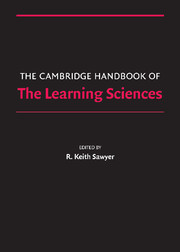Book contents
- Frontmatter
- Contents
- Preface
- Contributors
- 1 Introduction
- PART I FOUNDATIONS
- 2 Foundations and Opportunities for an Interdisciplinary Science of Learning
- 3 Constructionism
- 4 Cognitive Apprenticeship
- 5 Cognitive Tutors
- 6 Learning in Activity
- 7 Knowledge Building
- PART II METHODOLOGIES
- PART III THE NATURE OF KNOWLEDGE
- PART IV MAKING KNOWLEDGE VISIBLE
- PART V LEARNING TOGETHER
- PART VI LEARNING ENVIRONMENTS
- Afterword: After How Comes What
- Epilogue: The Fundamental Issue in the Learning Sciences
- Author Index
- Subject Index
- References
3 - Constructionism
Published online by Cambridge University Press: 05 June 2012
- Frontmatter
- Contents
- Preface
- Contributors
- 1 Introduction
- PART I FOUNDATIONS
- 2 Foundations and Opportunities for an Interdisciplinary Science of Learning
- 3 Constructionism
- 4 Cognitive Apprenticeship
- 5 Cognitive Tutors
- 6 Learning in Activity
- 7 Knowledge Building
- PART II METHODOLOGIES
- PART III THE NATURE OF KNOWLEDGE
- PART IV MAKING KNOWLEDGE VISIBLE
- PART V LEARNING TOGETHER
- PART VI LEARNING ENVIRONMENTS
- Afterword: After How Comes What
- Epilogue: The Fundamental Issue in the Learning Sciences
- Author Index
- Subject Index
- References
Summary
Learning sciences researchers are unified by their deep commitment to radically transform learning – away from the transmission and acquisition style associated with lectures and quizzes, to a more active, participatory learning style. Perhaps the first scholar to realize that computers provided schools with an opportunity to do so was Seymour Papert, who created the now-famous Logo programming language. Papert, who received two doctorates in mathematics, expanded his career by studying cognitive development with Jean Piaget, the founder of constructivism – one of the theoretical foundations of today's learning sciences. After leaving Piaget's lab in Switzerland, Papert took a faculty position at the Massachusetts Institute of Technology, where he cofounded the Artificial Intelligence Laboratory with Marvin Minsky. In the 1970s, Papert began to expand the psychological insights of Piaget's constructivism into pedagogical principles, providing a template that later influenced many learning sciences researchers.
When Papert's book Mindstorms was published in 1980 the term constructionism had yet to be coined. In this book and subsequent publications he advanced a theory of learning, teaching, and design. Many took the notion of “children, computers and powerful ideas” (to quote the subtitle of his book) as a rather simplistic version of Piagetian discovery learning with the Logo programming language when, in fact, the opposite applied. Constructionism is not constructivism, as Piaget never intended his theory of knowledge development to be a theory of learning and teaching; nor is constructionist learning simply discovery learning and thus opposed to any forms of instruction; and last, in constructionism, people and not computers are seen as the driving force for educational change.
- Type
- Chapter
- Information
- The Cambridge Handbook of the Learning Sciences , pp. 35 - 46Publisher: Cambridge University PressPrint publication year: 2005
References
- 23
- Cited by



